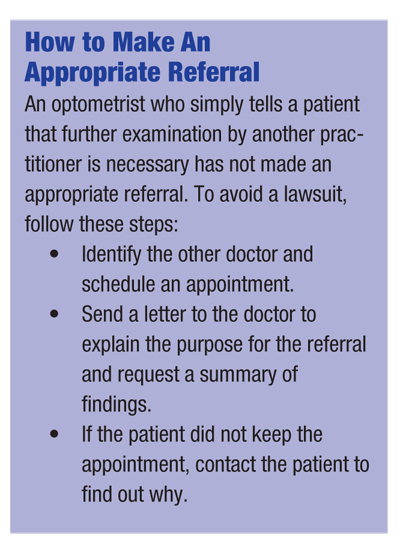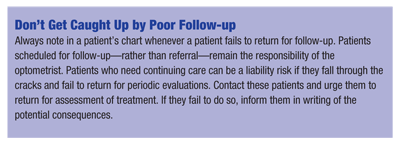 It used to be that getting slapped with a malpractice suit was not a major worry for O.D.s. However, as optometrists have expanded their scope of practice in recent years, lawsuits against O.D.s have increased. So, how do you continue to be a competent, caring and able O.D. without harboring a nagging worry that you are going to get served with a lawsuit at any moment?
It used to be that getting slapped with a malpractice suit was not a major worry for O.D.s. However, as optometrists have expanded their scope of practice in recent years, lawsuits against O.D.s have increased. So, how do you continue to be a competent, caring and able O.D. without harboring a nagging worry that you are going to get served with a lawsuit at any moment?
Some legal experts say there is nothing you can do to completely avoid a lawsuiteven if you practice to a high standard, treat your patients well, and keep your patients informed about what you intend to do and the results that you have found. However, although no practitioner is completely immune to malpractice suits, you can follow certain steps to reduce the chances of facing a claim against you and against your practice.
A Few Simple Rules
Any fool can sue and often does, says Michael Harris, O.D., J.D., of the University of California Berkeley School of Optometry. But, you minimize the likelihood of a lawsuit by following a few basic principles that many O.D.s already embrace.
To begin with, follow the standard of care of the profession. Practice in a fashion that a reputable optometrist would; have a thorough case history, do any tests necessary, and provide an accurate diagnosis, he says.
Does your level of care meet the standard of care for your particular mode of practice? asks Robert Dister, O.D., J.D., also of UC Berkeley School of Optometry. This means keeping current with the latest developments in optometric practice and knowledge and applying them to the diagnosis and treatment of your patients, he says.
More to the point: Have you addressed the patients complaints? Make sure your exam has thoughtfully addressed what the patient is complaining about, and that your conclusion explains the findings and the complaint, says
Chairside Manner
The other simple rule is to polish up your chairside manner. It is important to have a good rapport with your patient, Dr. Harris says. Patients rarely sue doctors they like unless the doctor does something egregious. If you establish a rapport, you can generally work it outwhatever has gone awry.
Good communication is critical and can defuse negative feelings against an optometrist should complications or problems arise. If a patient gets a new pair of glasses and comes back saying he still cant see properly, be understanding, not defensive. Consider that you may have missed something, Dr. Steinberg says. Even if you think the patient is the problem, show concern and give him your attention.
If a patient is unhappy, be helpful. If your attitude is antagonistic or the patient feels shunned or ignored by you, he may look to blame you if something goes wrong; and he is more likely to sue you, Dr. Steinberg says. Even when a doctor makes a mistake, he or she is less likely to get sued if he or she communicates well and has a good relationship with the patient, he adds.
In addition to following the standard of care, treat all of your patients with the courtesy, concern, compassion and professionalism that you would extend to a close personal friend or relative, Dr. Dister says.
In nearly every community, there is a doctor who practices at a level significantly below the standard of care, but who has a very successful practice and has never been sued, Dr. Dister says. These doctors are often those who are friendly and personable and who establish an ongoing rapport with their patients who would probably consider bringing a lawsuit only under extreme or unusual circumstancesand perhaps not even then. The skilled practitioner with no chairside manner is more likely to wind up in court, he says.
Informed Consent
Another simple rule to follow: Do a good job of explaining a procedure prior to performing it and discuss its results after performing it.
The legal doctrine of informed consent requires that a patient must be made familiar with the risks of and alternatives to a treatment. This holds true even for simple, routine things, Dr. Dister says, such as prescribing extended wear contact lenses or an ocular medication with potential side effects.
Informing the patient of risks and treatment options beforehand and having the patient acknowledge it in writing is beneficial in two ways, he says. First, an informed patient is less likely to be unpleasantly surprised by a treatment outcome and, therefore, less likely to bring a lawsuit in anger. Second, a signed informed consent agreement can serve as valuable evidence that a patient received the information necessary to make an informed decision about his or her care.
 Once you make sure that your patients understand proper consent and understand the risks, also be aware of negligent entrustment if you refer a patient to an M.D. You wouldnt give the keys to the car to a 12-year-old, Dr. Harris says.
Once you make sure that your patients understand proper consent and understand the risks, also be aware of negligent entrustment if you refer a patient to an M.D. You wouldnt give the keys to the car to a 12-year-old, Dr. Harris says.
In addition, follow comanagement protocols and dont be afraid to make referrals when warranted, as a reluctance to do so can lead to malpractice. You can tell a patient I can do it, but I think an ophthalmologist may be better in this case, Dr. Steinberg says. He warns not to ever let your ego prevent you from making a referral.
Keep Accurate Records
Dont add or delete information from a chart, even if you think that you are doing it appropriately. Records are a witness that never dies, Dr. Harris says. What is not documented can be assumed to be not provided.
Your records will be your lifeblood. Poor records will haunt you, Dr. Harris says. So, keep records for at least seven years after seeing a patient.

If you make corrections to your chart in the form of additions or deletions, you should make it clear that an alteration has been made by initialing and dating the changes. Make deletions by drawing a line through the material, rather than erasing it. Lining out, initialing and dating makes it clear that the changes to your chart were made in good faith rather than in an attempt to hide an error. Above all, never make any alterations to the documents after a lawsuit has been filed in an attempt to make your case stronger. Experts will have little trouble recognizing your efforts at tampering with evidence, and the result will be detrimental to you and your case, Dr. Dister says.
Dr. Harris recounts a classic story of an O.D. who got sued and made changes to the patients record in red ink, while the original record was in blue ink. When the optometrist got subpoenaed for all his records, it was obvious that the optometrist added information to the patients chart because all the other records were written entirely in blue ink.
You Got Sued. Now What?
If you are facing a lawsuit, what is the first thing you should do? The experts agree: Contact your insurance company immediately. If you dont inform your insurance company immediately, you may lose coverage. Once you make contact with your insurer, follow their instructions as to how to send the original documents to them (usually by certified mail after having made a photocopy) and any other actions you should take.
It is important to contact your insurer without delay because some policies will have a provision stating that their duty to cover you is waived if you do not give notice of a legal claim within a certain number of days after it was served upon you, Dr. Dister says.
Place any relevant records, files, paperwork or other documents in a safe place. It looks very bad if important documents have somehow disappeared, he says. As a backup, make photocopies of any relevant documents and store them at a separate location.
Even if you arent served with a lawsuit yet but expect you may be, put your insurance company on notice that something is pending, Dr. Steinberg says. Some insurance companies require prompt notice of actual or potential claims and could deny coverage if you delay in proving that notice.
Listen to the advice of your insurance company and follow their direction. Let them handle it, Dr. Harris says. Keep in mind your insurance company may handle the claim in a way you may not agree with and they may decide to settle when you feel that you have done nothing wrong.
Even if you have a good relationship with the patient that sues you, dont call the patient unless you are advised to do so by your attorney. Remember, whatever you say most likely will be brought up during the case. Calling your patient to say you are sorry might not be the best course of action.
If you get in a car accident, it is OK to get out and say Are you hurt? Dr. Steinberg says. But you dont want to say Im really sorry. I didnt see you coming, since you then admit that you were at fault.
Saying you are sorry before the lawsuit is filed is another matter. There has been a recent movement in the medical field to try and minimize the number of malpractice lawsuits and the damages awarded via the simple mechanism of having doctors say Im sorry when they make a mistake, says Dr. Dister.
It seems that, in general, patients are more forgiving than doctors and their attorneys would have surmised. While it is probably not a good idea to admit fault to a patient without consulting your insurer or an attorney beforehand, the simple act of showing concern and saying that you are sorry that a particular treatment or procedure is not working to the patients satisfaction, and telling the patient that you will do all that you can to try and make them happy and satisfied will often make a difference in whether or not the patient chooses to bring a lawsuit, Dr. Dister says.
Deposition Tips
The purpose of a deposition is to give the opposing side the opportunity to learn the facts of the case. You should answer questions truthfully; but it is unwise to volunteer any information that was not specifically asked for by the question, Dr. Dister says.
Keep your answers short and to the point. Follow your attorneys instructions. There is no judge or jury present, so a deposition is not the place to plead the merits of your case, he says. In other words, be truthful and terse.
Listen to the questions being asked during the deposition. People being deposed often want to tell their side of the story, and they dont answer the question that was asked but answer the question they wanted asked. If a question calls for a yes or no answer, the answer should start with yes or no. Not answering yes or no is what the deposing attorney wants, Dr. Steinberg says. There is nothing more a plaintiff attorney wants than a conversation with you.
Also, dont volunteer information. Answer the question and stop. Let the plaintiffs attorney ask the follow-up question. Dont assume a follow-up question will be asked and answer without being posed the question. Remember, you are the expert. The attorney may not know the right question to ask.
Above all, listen to your lawyers advice and tell the truth. If you lie and its discovered, you are history and your credibility is gone, Dr. Steinberg says.
Mistakes Happen
The best way to avoid a lawsuit is not to make a mistake. However, mistakes do happeneven amongst the most seasoned O.D.s. First of all, doctors shouldnt beat themselves up if they do get sued, Dr. Steinberg says. It shouldnt be disheartening. The reality is a lot of lawsuits dont have merit. A lot are due to a bad result, not bad doctoring.
Even if you dilate every patient and look at every fundus, there may be a tumor that you miss. Anyone can miss something, Dr. Steinberg says. If you miss something or make a mistake, take it to heart and learn from it.

